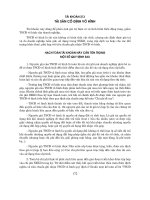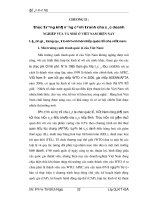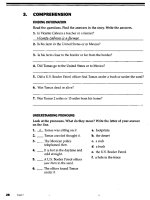ACCA Burying the Billable Hour phần 4 doc
Bạn đang xem bản rút gọn của tài liệu. Xem và tải ngay bản đầy đủ của tài liệu tại đây (126.99 KB, 14 trang )
and large, they will behave in a
manner that is consistent with
that obligation.
Quoting fixed prices projects
confidence and experience
Being able to quote a fixed price
before the service is performed
shows the customer that your
firm is experienced and
confident in its ability to
perform, a trait valued by the
customer, even if subjectively.
Imagine an airline not quoting
air fares before the flight, but
instead charging by the minute.
How would you feel? Would you
begin wondering if the pilot will
deliberately slow down? Would
it lower your confidence in the
airline?
Increases a customers
switching costs
The more services you perform
for the customer, the more you
know about a customer, the
more expensive it will be for the
customer to defect. Creating a
partnership with your customer
links both your destinies and
prosperity.
Forces your firm to be efficient
By offering fixed prices, you
must delegate the work to those
in your firm who can perform it
most efficaciously, and not let
surgeons pierce ears. It also
forces you to review every
procedure, work review level,
etc., and ensure that each task
adds value to the customer,
otherwise it should be
eliminated.
Overcomes buyers emotions
Price resistance (sticker shock),
price anxiety (buyers remorse)
and payment resistance (not
writing the cheque) will all
lessen by utilising FPAs. By
discussing value, price and
terms up-front, you will reduce
the negative impact of these
emotions on the customer, not
to mention raising your firms
profitability.
Prices can be increased each
year
When was the last time you
raised your hourly rate? Do you
believe there is a concomitant
PAGE 29
Implementing Value Pricing (continued)
increase in value to any one
customer? I can assure you
customers dont view the world
that way. However, when you
have customised services and
pricing for each customer, it is
easier to increase the price
annually even if no services have
been added to the FPA.
Provides a competitive
differentiation
Since each FPA is customised,
the perceived value of your firm
increases. In contrast, by using
hourly billing, you are simply
treating all customers the same,
which is not a prescription for
success in todays marketplace.
Customers prefer fixed prices,
up-front, and will continue to
gravitate to those firms who are
willing to offer them.
Bundling services results in
higher prices
Anytime you can bundle your
services together, you can
achieve higher prices because
the customer is now focused on
the totality of your service
offering, rather than each line
item.
This is obviously not an exhaustive
list of the advantages of Value
Pricing, just some of the most
important ones.
IMPORTANT QUESTIONS TO ASK
YOURSELF BEFORE SETTING A
PRICE
It is important to ask yourself, and
the team who works on the
customer, various questions in order
to price every customer at the profit-
optimising level. Here are some
questions I have found valuable to
consider within your firm before
setting a price:
Who on the organisational chart
are we dealing with?
The higher up, the less price-
sensitive.
Who referred the customer?
If its a warm referral, theyll be less
price-sensitive because chances are
you have already been pre-sold.
PAGE 30
Implementing Value Pricing (continued)
What are the timelines/deadlines in
selecting an accountant?
This is the convenience factor;
convenience stores and
McDonalds charge for it, so
should accountants.
Whos paying for the service?
Is the customer spending their
own money on themselves, or are
they spending someone elses
money? Airlines, hotels, rental
cars, for example, take this into
account in their pricing strategies.
Any competitors in the arena with
you? If so, who are they?
You probably know a lot about
your competition. How are you
differentiating your Value
Proposition from theirs, thereby
justifying a higher price?
How profitable is the company and
how long has it been in business?
The theory here is the more
profitable and longer theyve been
in business, the less price-sensitive
they will be.
Who was the prior accountant and
why are they changing?
You dont want to be the fifth
accountant in four years. Check
with the predecessor and find out
as much as you can about the
customer. Do not take all comers,
only those who value and are
willing to pay for your services.
Who is the banker, solicitor, etc?
Check their credit reports. As the
Ancient Greek philosophers used
to say, Character is destiny. Only
work with people of character.
What price do we desire?
This is an important question.
Although there is no doubt that it
is the customer who ultimately
sets the final price, the firm should
have a reservation price for the
services to be performed. Never go
below this reservation price, and
dont be afraid to ask for it. There
is nothing holding you back except
your own fears.
(Baker, © 2001 Aspen Law & Business,
Professionals Guide to Value Pricing,
Third Edition, questions reproduced with
permission, p.173)
PAGE 31
Implementing Value Pricing (continued)
QUESTIONS TO ASK THE
CUSTOMER DURING THE FPA
MEETING
Here are some questions that
should be asked of each customer
during an FPA meeting or before
setting any type of price:
What do you expect from us?
Exceeding customer expectations
is critical in order to Value Price.
What keeps you awake at night?
There is not a businessperson alive
who doesnt suffer from some
affliction cash flow, tax issues,
competition, etc. Find out what it
is and help them solve it.
What dont you like about your
current accountant? What do you
like about your current
accountant?
These questions are not intended
to denigrate the predecessor, but
to assist you in not making the
same mistakes, and to exceed
what they did like about the
predecessor.
If price werent an issue, what
role would you want us to play in
your business?
This is an excellent question in
order to discover cross-selling
opportunities.
(Baker, © 2001 Aspen Law & Business,
Professionals Guide to Value Pricing, Third
Edition, questions reproduced with
permission, p.176)
The letter repoduced in Figure 5.2
shows the experience of one UK
accounting firm making the
transition from hourly billing to
Value Pricing, including abolishing
timesheets, which I advocate in
Professionals Guide to Value
Pricing, Third Edition.
CHANGE ORDERS
Change Orders are perhaps one of
the most innovative pricing
strategies ever developed. When a
service arises that was not
anticipated in the FPA, or when a
service falls outside of the scope
specified in the FPA, a Change
Order should be issued. It is a
wonderful communications tool, as
it puts the customer in charge of
authorising the engagement and
PAGE 32
Implementing Value Pricing (continued)
Hi Ron
I read your book about six months ago it is truly the best book Ive read on the profession. At the
time, I was doing some work for a client helping them buy a fairly substantial business, with turnover
of $2 million. We werent doing due diligence, but even so it was fairly involved. The time-based price
came to c. £4,500. With the confidence gained from your book, I doubled the price to £9,000. The
client paid within a week, said they couldnt have done it without us, and at our first client advisory
board, held last week, commented that with us, you get what you pay for if you pay peanuts, you get
monkeys. It works! I actually believe we would have found it harder to collect the smaller, time-based
price. But because we took the work seriously and charged accordingly, they treated it the same.
My co-director, Colin, and I both attended your London seminar a month or so ago [February 2000].
On the way back we committed to launching FPAs and abolishing timesheets.
Since then, we have begun the immense task of moving 750 clients to FPAs. It was interesting what
you said about meeting with your A [best] customers, and tailoring the FPA to their specific needs.
We absolutely want to do this, but currently dont have the time. I know how bad that sounds we
dont have the time to meet with our best clients. We have just taken on three extra people (we are a
two-director firm) so that will definitely help.
The intention is that, over the course of a year, we will move all clients onto FPAs. We felt that we
needed to cover all clients [rather than just the 20% who generate 80% of your revenue, as I advocate
in my book, at least as a starting point], not just our As, for the following reasons:
1. It is administratively simpler. Once all clients are on FPAs, billing becomes automatic, with the only
non-standard amounts being covered by Extra Work Orders [Change Orders].
2. Some benefits, such as no charge for phone calls, tax investigation insurance, and service guarantee
are easier to offer to all clients rather than to be selective.
3. We believe that the benefits of FPAs as currently offered are of use to the vast majority of clients.
4. We can only abolish timesheets if all clients are covered [I take exception to this particular point].
Figure 5.2
Our intention is to roll this out to all clients so that by March 2001 they are all on FPAs and we can
then abolish timesheets. From then on, we will sit down with our top 100 or so and tailor the FPA to
include specific Business Development initiatives. By that point, they will be comfortable with the FPA
concept, we should have freed up more time to deal with them on an individual basis, and we should
better understand the Business Development product offerings.
Most of these new services will not cost us much to provide. But as we hope the clients will see real
value from bundling, we are increasing the price compared to last year by an average of 20%. I feel
the package is worth more, but am not convinced clients will necessarily agree. Feedback so far has
been 100% positive about the principle, but we have had some moans about the price [thats just
sticker shock, and if they moan too loud, its probably a customer you shouldnt have anyway].
Regards, Stuart
SUMMARY
Changing the pricing culture in
your firm will not be easy. It takes
work, commitment and a
dedication of resources to training,
continuously educating your team,
and constantly confronting the
inherent challenges involved with
pricing. Pricing is far too
complicated to be left to the
antiquated billable hour
paradigm of rate multiplied by
hours, and deserves just as much
attention, creativity and
intellectual capital as the other
three Ps of your marketing strategy
(Product, Place and Promotion).
You will have to make the
transition at a pace that is
comfortable for you and your
approving the price, all before the
work is performed precisely
when the accountant possesses
the most leverage and thus will
obtain the highest price. Once
again, the Change Order illustrated
(see figure 5.3) is merely an
example to be tailored to your
firms culture, personality and that
of your customer.
Change Orders can also be used in
conjunction with innovative pricing
strategies. One of the most
innovative is the Retrospective
Price, or what is also known as the
Tip clause (To Insure
Performance), as shown in figure
5.4.
PAGE 35
Implementing Value Pricing (continued)
This clause can be used when you
are doing a significant project for a
customer where you know the
value you are adding is much
greater than any standard hourly
rate. Also, you must have a high
level of trust with the customer, as
when using the TIP clause you are
relinquishing your price leverage.
Also, if you perform auditing for
the customer and cannot accept
contingency type payments,
simply base the TIP on their level
of satisfaction with your service,
rather than any financial outcome
from the transaction. Consider the
story (see figure 5.5) from a US
CPA who utilised the Change
Order with the above
Retrospective Price clause.
Date:
Customer:
Date:
Project Description (and estimated completion date, if appropriate):
Price: £
We believe it is our responsibility to exceed your expectations. This Change Order is being prepared
because the above Project was not anticipated in our original Fixed Price Agreement, dated xx/xx/xx.
The price for the above project has been mutually agreed upon by Customer XYZ, and ABC,
Accountants. It is our goal to ensure that XYZ is never surprised by the price for any ABC service, and
therefore we have adopted the Change Order Policy. The price above is due and payable upon
completion of the project described [or, payable up-front, if agreed upon, or in instalments, etc.
whatever you and the customer agree to].
If you agree with the above Project Description and the price, please authorise and date the Change
Order below. A copy is enclosed for your records. Thank you for letting us serve you.
Sincerely,
Partner
ABC, Accountants
Agreed to and Authorised:
BY:
Customer, Director
XYZ
© 2001 Aspen Law & Business, Professionals Guide to Value Pricing, Third Edition, reprinted with permission.
Figure 5.3 Sample Change Order
customers. There is no need to
make the change all at once, it
can be done incrementally. Indeed,
it has been my experience that
most firms do just that. Test the
FPAs with a few customers,
develop some early successes,
share them with the team in your
firm, and your confidence will
increase and speed your transition
with other customers.
Including FPAs and Change Orders
in the pricing strategy of your firm
will allow you to develop better
relationships with your customers,
to increase your prices, to increase
customer satisfaction, loyalty, and
profitability, to cross-sell more
services, to increase accounts
receivable collection, to reduce
PAGE 37
Implementing Value Pricing (continued)
write-downs and write-offs, and to
enable you to stop sacrificing
profits on the Altar of the Almighty
Hour.
Figure 5.4 Sample Change Order
Clause Retrospective Price
(Non-Audit Customer)
In the event that we are able to satisfy
your needs in a timely and
professional manner, you have agreed
to review the situation and decide
whether, in the sole discretion of XYZ,
some additional payment to ABC is
appropriate in view of the overall value
of services rendered and/or the
financial results achieved, and/or your
satisfaction with our services, by XYZ
for this transaction.
Adapted from Baker, © 2001 Aspen Law &
Business, Professionals Guide to Value Pricing,
Third Edition, reprinted with permission, p. 211
Hello Ron,
Basically the large engagement was for a previous client that I had hired a controller for. He took over
the tax work, at my suggestion, as he was a CPA. The engagement was an exit and management
succession strategy which involved some fairly hefty income tax savings as well. The total time
expended was about 100 hours, although a lot of the time was on unrelated things that I did not want
to charge for due to the magnitude of the price (we quit using timesheets some time ago and have
substituted daily activity sheets to make sure our clients get billed, based upon our perceived value
of each engagement).
I used a flip chart in the presentation, pointing out the value of what they were getting. At the end of
the presentation I asked how much they thought it was worth, and suggested $300,000, $500,000,
a million? I wanted them to think in big numbers. The CEO was rather excited and said a million.
Knowing that this would be difficult to obtain in one fell swoop I suggested $400,000 down and a
retainer of $4,000 per month. They agreed but asked that I serve on the board of directors and attend
quarterly meetings through 2008, when the note to the previous owners would be paid off. They were
also kind enough to put me on salary so I could participate in their pension plan which is a 25%
direct contribution from the company. This all adds up to a little bit over $1 million.
Never once was the word time used or referred to by myself, or my client. They couldnt care less
about time. In all of our engagements, I never use the word. By concentrating on value and
encouraging the client to participate in the valuation of the engagement our prices have skyrocketed.
You were absolutely on target when you said that accountants are terrible at valuing our services
(myself included).
Keep up the wonderful work .
Gus
Figure 5.5
Final thoughts
PAGE 39
6
That Turkish proverb contains sage
advice, and I truly believe the
accounting profession has gone
down the wrong road in the past
fifty years by using hourly billing.
Although it certainly is a simple
pricing policy to maintain not
requiring much thought or
creativity the downside is
enormous. It is preventing
members of the accounting
profession from getting paid what
its customers already believe they
are worth. It is an idea for which
the French have the perfect
expression: fausse idée claire a
terrific idea that doesnt work.
By focusing on the concepts in this
booklet, you will begin to price on
purpose. Pricing will always be a
marketing issue, meaning that it
starts outside of the firm, with the
customer. Inward-focused pricing
methods, such as cost-plus pricing
and hourly billing, create the
problem of making the wrong
mistakes that is, you get no
feedback from the external
environment that enables you to
adjust your prices to reflect the
external value you provide. Lost
pricing opportunities and mistakes
simply dont show up on your
financial statements, or in your
hourly realisation reports, or in any
Activity Based Costing reports
they simply vanish into thin air.
And the lost opportunities are
enormous. A study by the
consulting firm McKinsey & Co. in
No matter how far you have gone
on the wrong road, turn back.
(Turkish Proverb)
PAGE 40
Final thoughts (continued)
Cleveland, Ohio compiled data on
over 1,000 companies and found
that a 1% increase in price, at
constant sales volume, would
produce an average of 7.4%
increase in profitability. In fact, the
McKinsey study showed that
pricing has a greater impact on
profitability than either sales
volume increases or cost
reductions.
However, the accounting
profession is mired in simplistic
me-too pricing, pegging their
prices based upon the competition
and an internal focus, while
ignoring the external value created
for the customer. Let us, together,
forge a new Declaration of
Independence for the accounting
profession, and once and for all,
free our profession from the
tyranny of time. It is time to bury
the billable hour. I do hope you
will join us.
Aquila, August J. and Allan D.
Koltin
How to Lose Clients Without
Really Trying. Journal of
Accountancy, May 1992.
Baker, Ronald J.
Professionals Guide to Value
Pricing, Third Edition. New York:
Aspen Law & Business, 2001.
Visit Aspens website at
www.aspenpublishers.com or call
1-800-638-8347.
Beckwith, Harry.
The Invisible Touch: The Four Keys
to Modern Marketing. New York:
Warner Books, 2000.
Flaherty, John E.
Peter Drucker: Shaping the
Managerial Mind. San Francisco:
Jossey-Bass Publishers, 1999.
Hamel, Gary.
Leading the Revolution. Boston,
Massachusetts: Harvard Business
School Press, 2000.
Krass, Peter (ed.).
The Book of Entrepreneurs
Wisdom: Classic Writings by
Legendary Entrepreneurs. New
York: John Wiley & Sons, Inc.,
1999.
LeBoeuf, Michael.
How to Win Customers and Keep
Them for Life. New York: Berkeley
Books, 2000.
Peters, Tom.
The Tom Peters Seminar: Crazy
Times Call for Crazy
Organizations. New York: Vintage
Books, 1994.
Pine II, B. Joseph and James H.
Gilmore.
The Experience Economy: Work Is
Theatre and Every Business a
Stage. Boston, Massachusetts:
Harvard Business School Press,
1999.
Reed, Richard C.
Billing Innovations: New Win-Win
Ways to End Hourly Billing.
Chicago: American Bar
Association, 1996.
Vishwanath, Vijay and David
Harding.
The Starbucks Effect. Harvard
Business Review, March-April
2000, p.17.
Williams, Roy H.
The Wizard of Ads: Turning Words
into Magic and Dreamers into
Millionaires. Austin, Texas: Bard
Press, 1998.
Winston, William J.(ed.).
Marketing for CPAs, Accountants,
and Tax Professionals. New York:
The Haworth Press, 1995.
References
£10
The Association of Chartered Certified Accountants
29 Lincolns Inn Fields London WC2A 3EE United Kingdom
tel: +44 (0)20 7396 5900 fax: +44 (0)20 7396 5959 www.accaglobal.com









